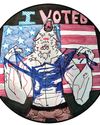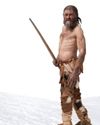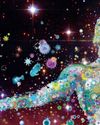Maryam Zaringhalam is a science and technology policy fellow through the American Association for the Advancement of Science.

She uses her knowledge and skills to help government officials reach decisions informed by science. Zaringhalam trained as a molecular biologist, but right now she’s working on a new mission—to get scientists to talk more openly about the messy process of research, not just the successes but the missteps and failures too. Fun fact: her scientific career began with a favorite toy.
WHEN YOU WERE GROWING UP, WHAT GOT YOU THINKING ABOUT A CAREER IN SCIENCE?
I really liked Legos. I just loved seeing the way the blocks came together to make a plane or a building. Then in ninth-grade biology, our class dissected a pig. As I was looking into this pig, looking at all the parts that were like parts that were inside me, I thought, this is kind of like a Lego—all these little organs and systems coming together. That experience sent me into genetics and molecular biology, because that’s a basic level at which parts come together to create a whole.
HOW DID YOUR EXPERIENCE AS A RESEARCHER LEAD YOU TO THINK ABOUT THE PLACE OF FAILURE IN SCIENCE?
Bu hikaye Muse Science Magazine for Kids dergisinin July/August 2018 sayısından alınmıştır.
Start your 7-day Magzter GOLD free trial to access thousands of curated premium stories, and 9,000+ magazines and newspapers.
Already a subscriber ? Giriş Yap
Bu hikaye Muse Science Magazine for Kids dergisinin July/August 2018 sayısından alınmıştır.
Start your 7-day Magzter GOLD free trial to access thousands of curated premium stories, and 9,000+ magazines and newspapers.
Already a subscriber? Giriş Yap

A 12-Year-Old Girl's Election Sticker Is a Winner
VOTING IS A FUNDAMENTAL FREEDOM FOR AMERICANS, A MEANS OF DOING ONE'S CIVIC DUTY AND A WAY AN INDIVIDUAL CAN EXPRESS THEIR VOICE. In 1971, the United States lowered its voting age to 18. But that doesn't mean kids and teens under 18 can't participate in elections in various ways.

If everything the human brain does is basically sets of electrical impulses, how exactly does that translate into a state of mind?
You're not the only one asking this question. Every neuroscientist in the world is wondering the exact same thing, says Zach Mainen

EARTH'S TINIEST BUILDERS
THE HIDDEN WORLD OF MICROBES IN THE EARTH'S CRUST

MUMMIES SPEAK
ABOUT MICROBES, MIGRATION, AND MORE

GOING WITH YOUR GUT
HOW DO MICROBES AFFECT OUR HEALTH? LET'S COUNT THE WAYS...

BUG Detective
A burglar sneaks into a house on a quiet street in New York City. He walks through the house, touching countertops and door handles. Finally, he steals a single card from a full deck. Then he leaves.

Little Creatures Among Us THE MANY MICROBES IN OUR DAILY LIVES
When you think you're alone, you're actually not. In the ground, the air, your room, and even your body are Strillions and trillions of creatures so tiny you can't see them.

A Mars Rock Found With Leopard Spots Could Be a Sign of Ancient Life
IN JULY, NASA'S PERSEVERANCE ROVER CAME ACROSS A SPOTTED ROCK IN WHAT WAS ONCE A RIVERBED IN THE JEZERO CRATER ON MARS.

Para Athlete Uses Exoskeleton Suit to Carry the Olympic Torch
In July, a 36-year-old French tennis para athlete, Kevin Piette, got a chance to participate in this summer’s Olympic torch relay without using a wheelchair.

Ancient Egyptians May Have Used a Water System to Lift Stones to Build Pyramid
HOW ANCIENT EGYPTIANS BUILT THE MASSIVE PYRAMIDS IN EGYPT MORE THAN 4,000 YEARS AGO HAS LONG BEEN A TOPIC OF WONDER AND DEBATE.